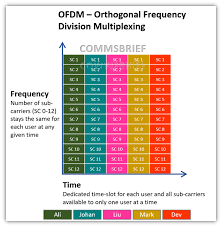
Orthogonal Frequency Division Multiplexing

Frequency Division Multiplexing.
image ©commsbrief.comOrthogonal Freequency Division Multiplexing is a mixture of frequency multiplexing, spliiting the available frequency into smaller sub chanels, and time division multiplexing, splitting the transmission into time slots. In an LTE environment these sub-channels are 15kHz blocks. and the time slices are 1ms.
Typically between sub-channels in a frequency division multiplexing system, there needs to be space between the channels but with orthogonal channels this space can be reduced to a minimum as orthogoanl channels do not interfere with their neighbour sub-channels.
On top of the mutiplexing, each subchannel has a modulation scheme imposed to maximise the data sent within a single wavelength with 64QAM a typical modulatuon scheme which has the abilkity to send 6 bits (values 0 to 63) on one wave.
The diagram show how OFDM works with a single "user" sending their transmission over a number of sub-channels, covering the whole channel. The issue with OFDM is that short transmissions do not cover the channel and there is space, unused spectrum which is inefficient.
© mobilephonetechnology.co.uk all rights reserved 2017-2025
